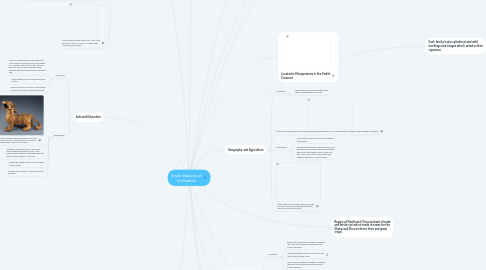
1. Religion
1.1. Sumerians
1.1.1. Sumerians originally practiced a polytheistic religion.
1.1.2. Their places of worship were temples and ziggurats.
1.1.3. They believed that the gods had powerful forces which determined a human's fate.
1.1.4. Rituals, food sacrifices, and libations occurred in Temples daily.
1.2. Shang/Zhou
1.2.1. All shared the belief of polytheistic religion. Meaning people worshipped many gods
1.2.2. People would sometimes sacrifice themselve to make sure the god "Shang Ti" was happy.
1.2.3. People believed that if the spirits were not happy, tragedies could occur.
1.2.4. According to culture Shang Ti must be happy in order for everyone else to be happy.
1.2.5. Most of their art was made out of clay, only because it was so common in where they lived and stone wasn't.
2. Arts and Education
2.1. Sumerians
2.1.1. They also made cylinder seals which are small pieces of stone or clay, in the shape of a cylinder, that will fit in your purse or hang on a string like a necklace. They showed who you were and what you were like.
2.1.2. They created the first formal education system.
2.1.3. Their education took place in the temple and the people were taught by a priest.
2.2. Shang/Zhou
2.2.1. The Shang and Zhou Dynasties commonly used bronze to create their art. They also knew how to use tin and copper.
2.2.2. During the Shang Dynasty in 1600 BCE; They established formal schools. More schools were created or changed when the Zhou dynasty began in 1046 BCE.
2.2.3. During the Shang Dynasty schools were called "Xiang".
2.2.4. Schools were called "Xu" during the Zhou Dynasty
3. Government and Leaders
3.1. Sumerians
3.1.1. The Sumerians were credited for the invention of governement
3.1.2. There government was a combination of monarchy and democracy
3.1.3. Priests were the highest power and controlled the city states
3.2. ZIggurats were places built to worship their leaders and Gods
3.3. Shang/Zhou
3.3.1. The Zhou government was created when large groups of nomads led by King Wen overran the government of The Shang.
3.3.2. The Shang 's King was the lawmaker and the judge of the entire government. He was not a person people messed with.
3.3.3. Anyone one who did not obey the laws of the king would be killed immediately by his soldiers.
3.3.4. The Zhou King used feudalism to keep peace with the biggest families in China by giving them land and protection while the families ran certain regions of the king's land.
4. Located in Mesopotamia in the Fertile Crescent
5. Each family had a cylindrical seal with markings and images which acted as their signature.
6. Most families lived in small houses made from clay bricks and reeds.
7. The climate there is very hot, so people had to move near the rivers.
8. The main crops that are grown there are barley and wheat.
9. Chinese starting making bronze around 2000 B.C. by molding it.
10. Region of Northeast China had wet climate and fertile soil which made it easier for the Shang and Zhou to thrive their and grow crops.
11. The Zhou were highly developed in warfare technology. They made Iron weapons like swords and also made shields.
12. Geography and Agriculture
12.1. Sumerians
12.1.1. Mesopotamia is divided into two parts: upper Mesopotamia and Sumer
12.2. Huang He River flooded but the Shang later discovered how to use flooded water to make complex irrigation systems.
12.3. Shang/Zhou
12.3.1. Millet and Rice were the main crops grown by the Zhou.
12.3.2. Yangtze River and the Huang He River were the main rivers in China. The Shang and the Zhou both used these rivers to grow rice and other crops. These rivers fueled the irrigation systems in ancient China.
12.4. They made the first wheel which was used for carts, chariots and pottery making(as seen in economy and trade)
13. Science and Technology
13.1. Sumerians
13.1.1. They came up with the concept of dividing the hour into 60 minutes and the minute into 60 seconds.
13.1.2. They developed a system of sewers to get rid of waste in their cities.
13.1.3. They came up with the concept of dividing the hour into 60 minutes and the minute into 60 seconds.
13.2. When the Zhou eventually took over China they began using pesticides and fertilizer like manure. Pesticides protected their crops from pests and other natural invaders.
13.3. Shang/Zhou
13.3.1. Earliest writing found in China was during the Shang dynasty. The Shang people wrote on tortoiseshells and even engraved writing into bronze art.
13.3.2. The Shang started to use writing on bronze artifacts like the one pictured around 1400 BCE.
14. Economy and Trade
14.1. Sumerians
14.1.1. Sumerian economy was based on agriculture.
14.1.2. Their jobs included pottery makers, stone-cutters, bricklayers, metal smiths, farmers, fishers, shepherds, weavers, leather-workers, sailors and many more.
14.1.3. They used slaves, although they were not a major part of their economy.
14.1.4. They made the first wheel which was used for carts, chariots and pottery making
14.2. Shang/Zhou
14.2.1. Fishing was a common business in the Shang Zhou.
14.2.2. Slaves made up a large portion of the Shang economy.
14.2.3. Agriculture was most important for the people and the economy.
15. Social Structure and Family Life
15.1. Sumerians
15.1.1. The Sumerian society was made up of four social classes:nobles, commoners, clients and slaves.
15.1.2. The man was the head of the family and could have more than one wife.
15.2. Shang/Zhou
15.2.1. The Zhou social structure recognized four types of people: Scholars who were called 'Shi' were placed the highest.
15.2.2. Second highest were farmers and peasants who were called 'Nong'.
15.2.3. Third were Artisans and craftsmen 'Gong'.
15.2.4. Placed fourth and final were merchants and traders; Which the Zhou named Shang.

